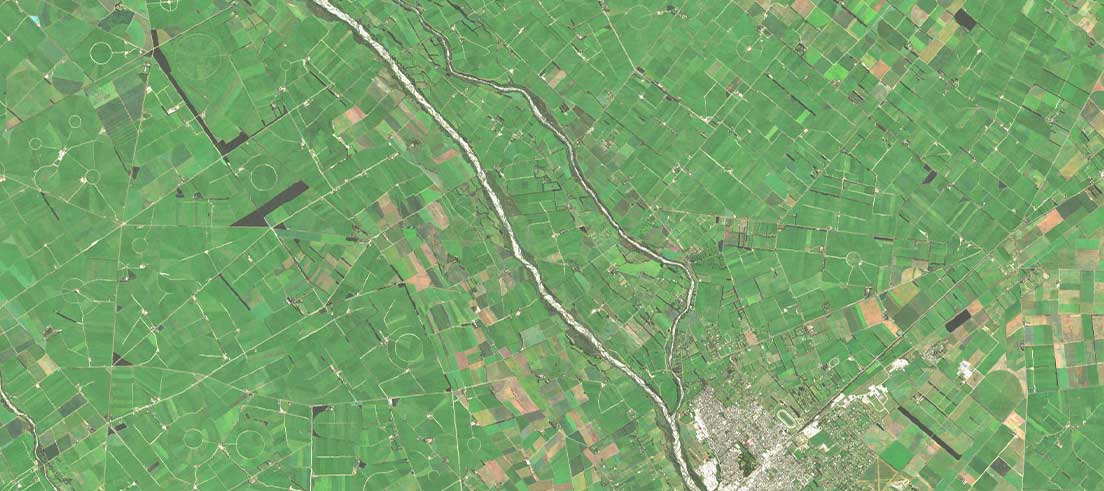
What’s the story about Greenstreet Creek
Dry conditions and low flow have resulted in the loss of aquatic life in Ashburton's Greenstreet Creek. Stay up to date with the efforts to salvage fish and protect the overall water quality and flow across the wider Ashburton River catchment.
Latest update – 21 March 2024
Chief Executive Dr Stefanie Rixecker has made the decision to allow water to be diverted into Greenstreet Creek.
We’re aware of the community’s frustration regarding the recent fish strandings at Greenstreet Creek and acknowledge we haven’t kept the community well informed.
The bigger picture is that we are amidst the impacts of the El Niño weather pattern and climate change, here and now, and we’re seeing very dry riverbeds across Canterbury.
Added to this, we’re the largest region in the country, with the greatest number of rivers and freshwater sources (78,000km of rivers and streams; 70% of the country’s groundwater) – we’re water central of Aotearoa New Zealand.
This means challenges and the need to make trade-offs – tough calls that weren’t made by previous generations are here and now.
The Ashburton River/Hakatere is an over-allocated catchment with significant challenges, including natural changes in modified environments. We recently undertook water take consent reviews on this part of the Ashburton River/Hakatere, precisely because of these challenges.
The decisions that came from the water take consent reviews are what our team has been working through and grappling with in this particular case. These changes are tough on communities – communities who deserve better conversations about the changes.
Better approach needed to support community
We need a better approach to “just transitions” – supporting our region to adapt to the effects of climate change in as fair a manner as possible.
As Chief Executive, I’m making the call to allow water to be diverted into Greenstreet Creek.
I’m making this decision in the face of climate change and in recognition that we didn’t get the “just transition” conversation right; we own that.
This is not the only place in Canterbury that we will face a challenge like this, but we must work better with our communities and landowners, our rūnanga partners, and the wider public.
The diversion is the immediate action in this current situation. However, future conversations need to happen about how we recognise the needs and interests of the community, our rūnanga partners and the environment itself, to make the hard calls together.
Lastly, I'd like to acknowledge the fish salvage work undertaken by Fish and Game and the local community over recent days – thank you.
Previous updates
20 March 2024
While our local team has been responding to landowners and impacted consent holders about this issue, we hadn’t updated the wider community and we’re sincerely sorry for this omission – we could have responded to community concerns with this information much sooner.
Here's what we know:
Restrictions and rules are in place
It’s highly regrettable that there has been a loss of aquatic life in this stream and we acknowledge the fish salvage work undertaken by Fish and Game and the community. There are irrigation restrictions and consent conditions that are in place to protect the overall water quality and flow across the wider Ashburton River catchment – so allowing additional water into this creek it is not a straightforward request. It’s also unlikely that adding additional water at such a dry period would provide anything other than a very temporary solution.
Next steps
Taking all of this on board – we are immediately addressing how we can work better, and update the community faster, when we become aware of incidents like this.
Further information
All rivers in the Ashburton catchment are currently on full restriction. This means consent holders are prohibited from taking water from any waterway in the catchment, regardless of the purpose. In the coming months, if sufficient rainfall occurs, we would then expect to see water naturally in the creek.
Minimum flows were established during Ashburton River plan development (made operative in 2015) with the community to protect the waterways’ values and for people and the environment within the Hakatere/Ashburton River catchment. The Ashburton Water Consents Review was carried out in 2018-2022 to implement these minimum flows on consent conditions. New minimum flows restrictions became effective from 1 July 2023 for all consent holders within the Ashburton catchment. The Ashburton Consent Review process did anticipate that such circumstance would occur from time to time, and with it also being a very dry year, the impact of that consent review has been felt sharply. The review was supported by the Ashburton Water Zone Committee.
It should be noted that winter 2023 and early spring were relatively wet compared to other years. However, climate conditions have shifted to El Niño and, as a result, the past few months have been warm and dry. With the lack of significant rainfall and lack of snowmelt (from a dry winter) occurring, river flows are decreasing throughout the region, especially in all our foothill and lowland rivers.
Many river flows are below their minimum flows and most consent holders are on full restriction, including the tributaries and mainstem of the Ashburton/Hakatere River. The temporary discharge of water such as that requested by the consent holders of Greenstreet Creek would not be a long-term solution to protect instream life such as tuna and fish.
A continual water take and release to Greenstreet Creek would be needed to augment the creek even then, due to dry conditions in the catchment, there would be no guarantee that the flow from Greenstreet Creek would be sufficient to allow connection with mainstem Ashburton flows.
